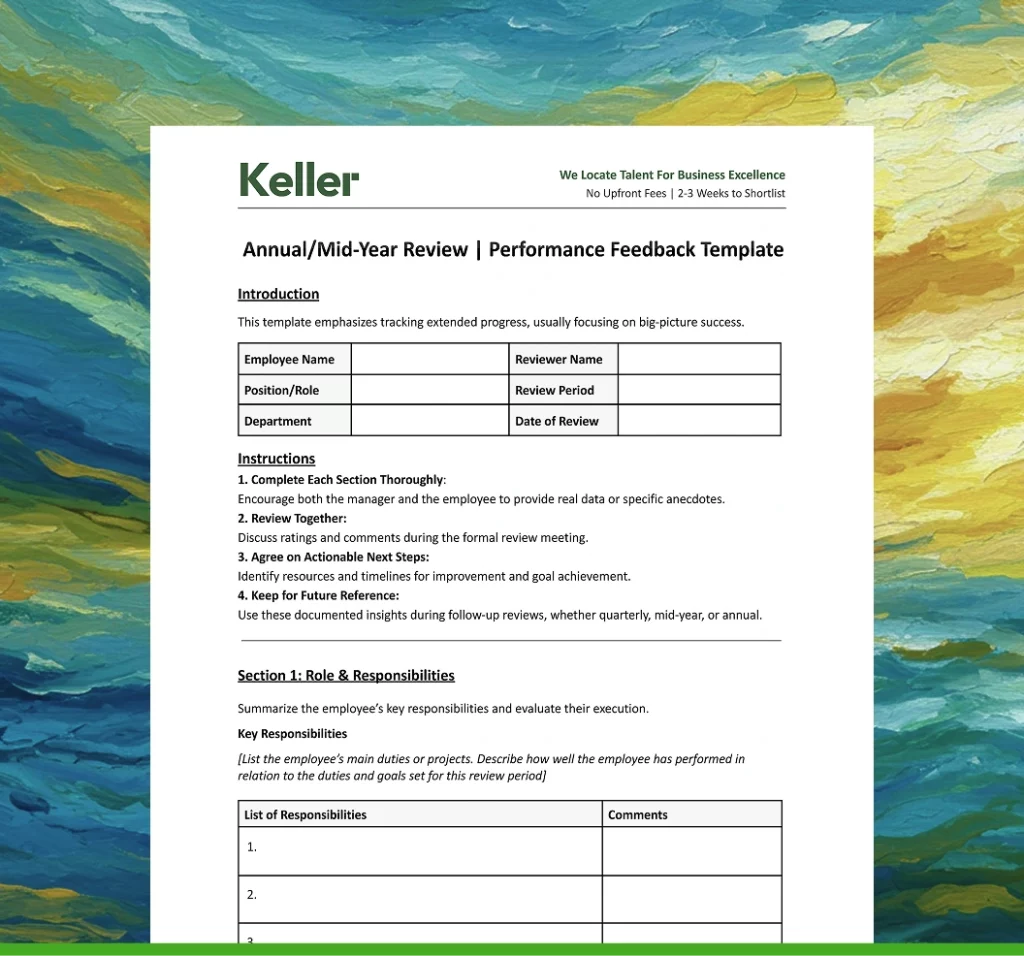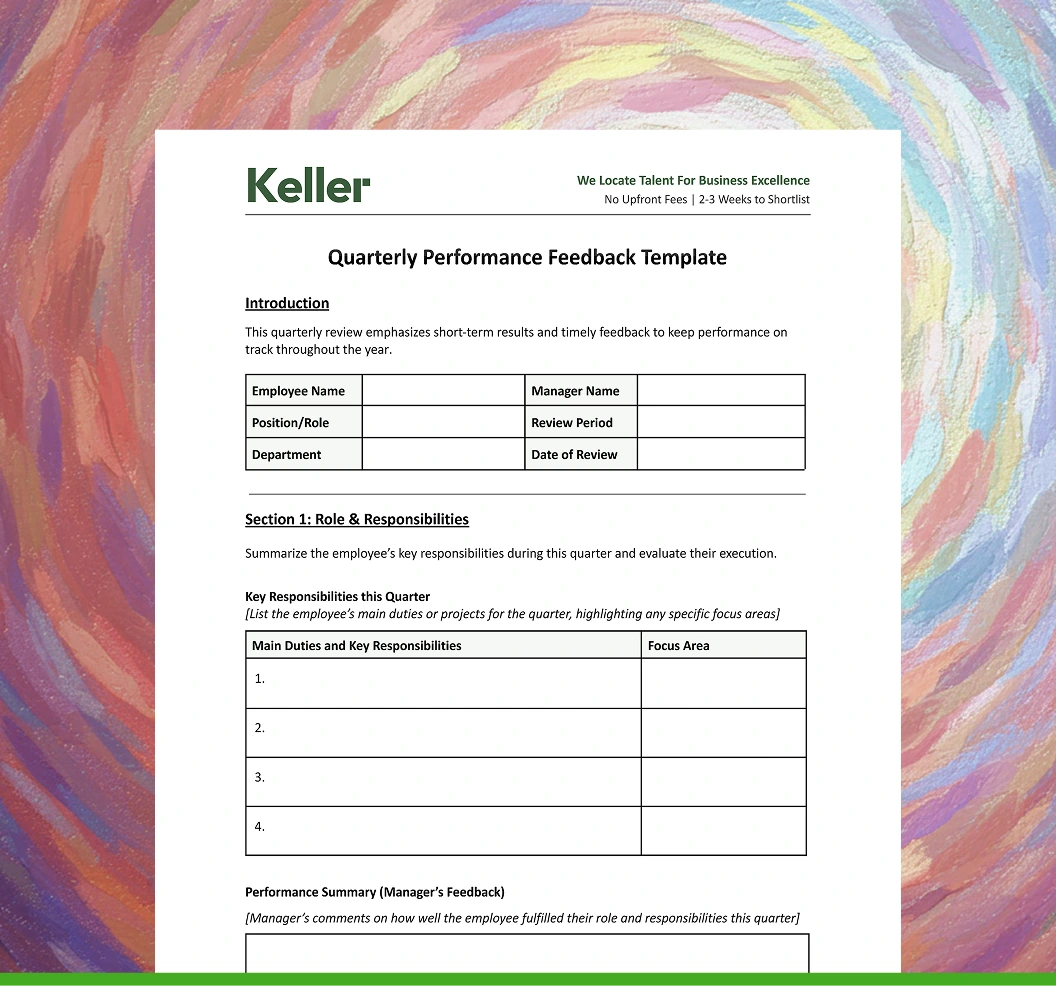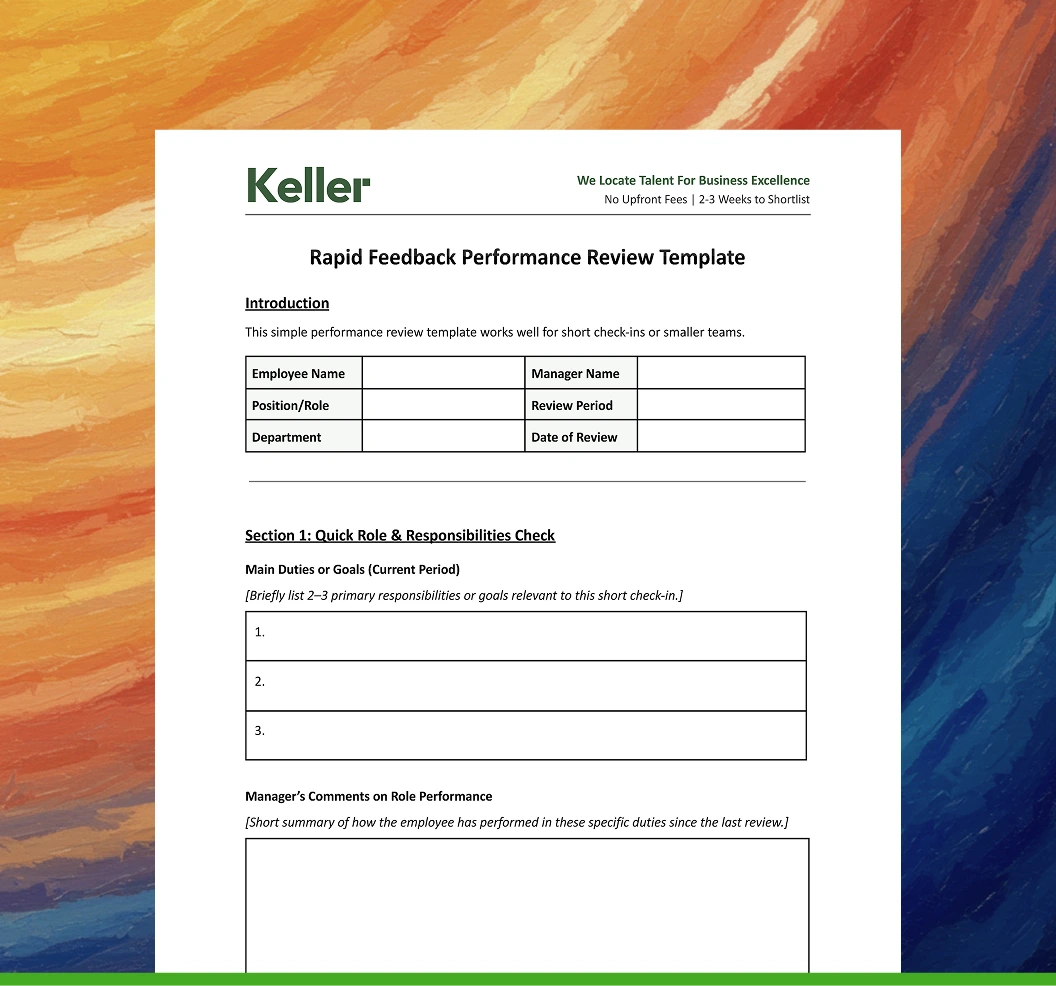Templates & GuidesPerformance Management
Performance Feedback Template Forms For Employee Reviews
Download Template
A thoughtfully designed performance feedback form is a vital resource for organizations striving to assess each individual’s contributions and guide improvement. By relying on systematic performance reviews, organizations create a foundation for open communication and long-term success.
A balanced and well-structured employee performance review form often leads to higher engagement, accountability, and more transparent conversations across various levels. These forms are especially helpful for managers and employees who need a consistent way to document progress and set goals that align with broader organizational goals.
Key Elements of a Performance Feedback Form Template
An effective template ensures that an employee’s performance is reviewed thoroughly and fairly. It should capture job performance metrics, allow space for specific examples, and clarify expectations over the review period. Below are essential sections every template should consider:
- Role and Responsibilities
- Core Competencies
- Achievements & Contributions
- Areas for Improvement & Development
- Development Plan and Action Steps
- Employee Self-Assessment
Different Types of Performance Reviews
Annual and Mid-Year Review Forms
An annual performance review template covers a 12-month period and looks at whether goals were met and how effectively employees contributed to overall operations. This evaluation process generally uses yearly data to assess alignment with strategic objectives. However, many organizations add a mid-year performance review to check progress halfway through the year. This mid-cycle check ensures that employee performance reports capture updates effectively, letting management adjust objectives if needed. Download Template

- Annual performance review: Tracks extended progress, usually focusing on big-picture success.
- Midyear performance review: Offers managers a chance to course-correct and provide timely feedback before the full year concludes.
Quarterly Review Options
A quarterly performance review template is often used for shorter cycles. Some quarterly performance evaluations companies develop aim to identify quick wins and areas that need change every few months. This more frequent review process makes it easier to assess employee performance in real time and keep managers and employees aligned. Download Template

- Quarterly performance review sessions may track key performance indicators like sales numbers or project delivery rates.
- Allows employees to adapt faster and managers to intervene sooner if there are signs of underperformance.
Simple Performance Review Template for Rapid Feedback
A simple performance review template works well for short check-ins or smaller teams. This sort of performance review form often has limited sections: goals, recent achievements, and immediate challenges. Despite its brevity, it still provides room for constructive feedback and sets the stage for continuous improvement. Download Template

- Works especially well for remote or agile teams needing quick updates.
- Can be merged into daily or weekly coaching sessions.
Strategies for Constructive Feedback and Professional Development

Well-rounded employee feedback combines praise with strategies for improvement. A manager who can provide constructive feedback in a focused way often sees employees respond with higher motivation.
- Clarity and Respect: Keep comments specific. Instead of “You need to do better,” note, “Your written reports would benefit from clearer objectives.”
- Action-Oriented Steps: Link feedback to an action plan. Suggest training or mentorship to move forward.
- Communication Skills: Tailor the conversation so employees feel respected and open to discussing their challenges.
Properly delivered constructive feedback ensures professional development stays on track and fosters a culture of support. It also boosts employee engagement because individuals see a real path for growth within the organization.
Driving Employee Growth Through Performance Reviews
Thoughtful performance reviews are vital for employee development, highlighting strengths and giving guidance on next steps. This process becomes even more powerful when it’s backed by evidence and consistent feedback over multiple cycles.
- Tracking Key Performance Indicators: Ties individual efforts to organizational goals.
- Team Collaboration: Encouraging team members to help each other can boost overall success.
- Improve Performance: Frequent reviews pinpoint performance barriers early, letting managers fix problems before they escalate.
- Employee Growth: A steady influx of objective data, balanced feedback, and supportive dialogue helps each person refine their abilities.
By including opportunities for professional growth—like added responsibilities or external courses—organizations turn reviews into catalysts for better employee’s performance.

Next Steps
Leaders that prioritize clear performance reviews and consistent performance evaluations typically see improved morale and higher productivity levels in their teams. The primary goals of an effective performance review should always be to help team members understand their progress, set new milestones, and work in sync with overall objectives.
As you finalize your performance review, focus on clarity, fairness, and open communication. This approach will ensure employee’s performance remains strong, and annual reviews become a meaningful checkpoint rather than a routine formality.
By combining detailed feedback, objective data, and two-way dialogue, organizations create a supportive environment where people thrive. This yields long-term value as employees grow in their roles, and the company benefits from consistent gains in productivity, innovation, and commitment.










